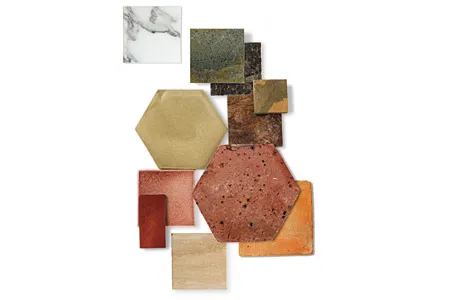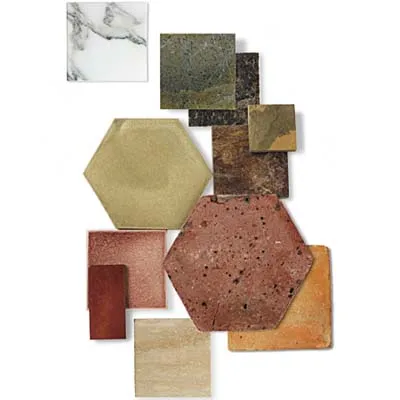
Hearth tiles are a practical but classic design choice. They protect the floor from heat and stray embers, creating a safe zone around the fireplace. The right tiles can increase your home’s value and create a warm, inviting atmosphere that draws in family and guests alike. Various options, from classic marble to rustic terra-cotta, can complement your home’s decor while providing long-lasting safety and heat resistance. This guide will explore different tile materials, installation techniques, and design choices to help you create the perfect hearth for your home.
Factors To Consider When Choosing Hearth Tiles
Here are some key factors to keep in mind when choosing the right tiles for your hearth:
- Appearance: The tiles you choose should complement your fireplace design and home decor. Consider color, texture, and pattern when making your selection, as the hearth is often a central feature in many homes.
- Budget: Hearth tiles vary widely in price, from budget-friendly ceramic options to high-end natural stone. If you’re not planning a DIY project, remember to factor in installation costs.
- Durability: Your hearth will likely have heavy foot traffic and occasional impacts from dropped logs. Pick tiles that resist wear and tear without chipping or cracking. Porcelain and granite are known for being strong and lasting a long time.
- Heat Resistance: Your hearth tiles should withstand high temperatures and fire without cracking or discoloring. Natural stone options like granite and slate are great for their heat-resistant properties.
Types of Tiles Suitable for Hearths
When choosing tiles for your hearth, pick materials that can withstand high temperatures and frequent use. Here are some popular options:
Marble

Marble is a classic and elegant heat-resistant choice. Its natural veining patterns look luxurious next to any fireplace setting. High-grade marble is one of the more expensive flooring options, ranging anywhere from $19 to $60 per square foot, according to Angi. However, you can get marble that may not be as visually appealing but costs way less, from $3–$7 per square foot.
Granite
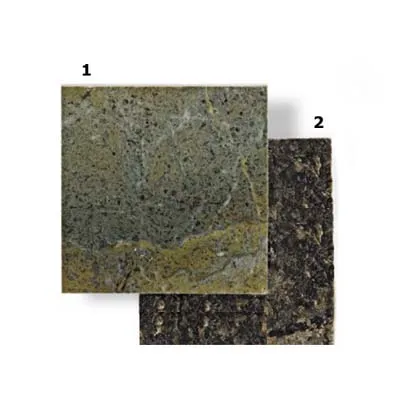
Granite is robust, resists heat, and comes in various colors and patterns. However, it tends to be more expensive than other options like ceramic, and can cost anywhere from $15 to $30.
Ceramic
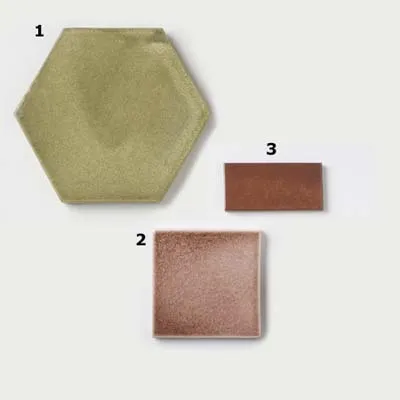
Ceramic tiles come in a variety of colors and patterns and are easy to clean. They also tend to be less expensive than other types of tile and are easier to cut, but can be less durable than materials like porcelain. The cost range is vast, from $7 to $45 per square foot, so you can find tiles to suit your design choices and budget.
Slate
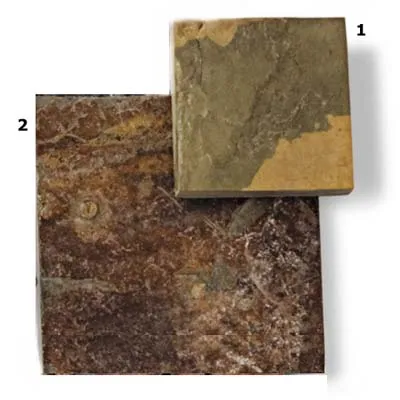
Slate tiles provide a natural, rustic look that is perfect for traditional or contemporary fireplaces. They’re often used for exterior steps, making for a durable and wear-resistant surface. Slate tile flooring costs range from $15 to $40 per square foot.
Terra-Cotta
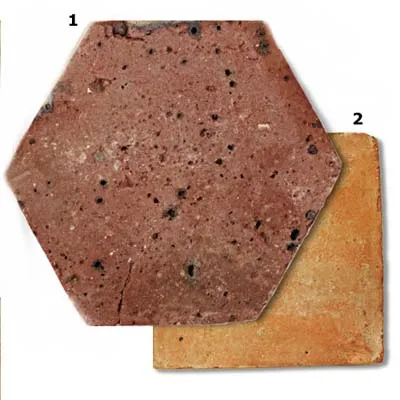
Terracotta tiles, with their natural reddish-brown color, bring a Mediterranean flair to hearths. They’re also highly durable and waterproof and, like other similar surfaces, easy to clean. Terracotta is cheaper than slate and granite, at about $7-$14 square feet.
Travertine
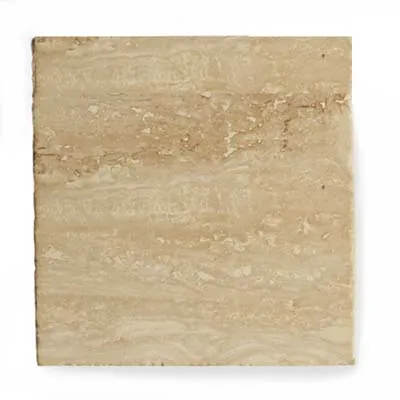
Travertine is a type of limestone with a pitted surface and natural color variations. It feels soft to walk on and is water resistant, so it’s often used in areas of the house that get a lot of visitors, like the living room, hallways, and even the bathroom. You’ll find travertine tiles for anywhere from $8 to $33 per square foot.
Porcelain
Porcelain tile is made from fired clay, comes in various styles, colors, and sizes, and can be used to create stunning designs. It is dense and highly resistant to wear and tear. It’s also less porous, which means better stain resistance. However, porcelain tiles are typically more expensive and can be more challenging to cut and install. Porcelain costs about $12–$40 per square foot.
Choose the Right Tile Size for Your Fireplace Hearth
Play with the size of your tiles to get the design you want. Larger tiles can create a sleek, modern appearance and are easier to install, while smaller tiles allow for more intricate patterns and designs. Account for the size of your hearth and the scale of your fireplace when selecting tile dimensions. A general rule of thumb is to use tiles proportional to the size of your hearth—larger hearths can accommodate bigger tiles, while smaller hearths may look better with more modestly sized tiles.
The Basics of Installing Hearth Tiles
Here’s a basic overview of how to carefully prep and install hearth tiles:
Step 1: Prep the Surface
The hearth surface should be clean, level, and free of dirt and debris. Repair any cracks or unevenness in the substrate. If needed, install a cement board as a base for better adhesion and heat resistance.
Step 2: Apply Adhesive
Use a high-quality, heat-resistant tile adhesive. Apply it evenly using a notched trowel, working in small sections to prevent the adhesive from drying before you can set the tiles.
Step 3: Lay the Tiles
Begin laying tiles from the center of the hearth, working your way outward. Use spacers to keep the gaps between the tiles even. Cut the tiles to fit around the edges and corners.
Step 4: Grout and Finish
Once the adhesive has set, apply grout between the tiles. Wipe away excess grout and allow it to dry completely. Seal the tiles and grout to protect against stains and moisture.
Maintenance and Care Tips for Hearth Tiles
To keep your hearth tiles looking their best:
- Clean regularly with a damp cloth or mop.
- Use pH-neutral cleaners to avoid damaging the tiles or grout.
- Reseal natural stone tiles annually to protect against stains.
- Fix any cracks or chips immediately to prevent further damage.
- Avoid using abrasive cleaning tools that could scratch the tile surface.
Popular Hearth Tile Designs and Patterns
Explore these design ideas to create a stunning hearth:
- Classic Patterns: Traditional herringbone or basketweave patterns work well with rectangular tiles and complement modern and traditional fireplace styles.
- Geometric Designs: From honeycomb-style hexagons to bold cross-hatch patterns, these designs are full of personality and flair. Use complementary colors to tie the design with your interior decor.
- Modern Layouts: Try large-format tiles in a simple grid pattern for a contemporary look. Alternatively, a staggered brick layout with long, narrow tiles can give a sleek, modern appearance.
- Mosaics: Custom designs can depict scenes or abstract patterns, making your fireplace a unique focal point. Combining different materials, such as glass and stone, can add texture and depth to the design.
- Rustic Styles: Natural stone tiles in irregular shapes can create a cozy, cabin-like feel. A mosaic pattern using small, square tiles can add rustic charm to your hearth.
Alternative Flooring Options for Hearths
While tiles are a popular choice, there are other materials to consider for your hearth:
- Brick: Consider using brick for your hearth for a traditional or rustic look. It’s heat-resistant and durable, though it may require more maintenance than tile or stone.
- Concrete: A poured concrete hearth can offer a sleek, modern look. It’s highly customizable in terms of color and finish, but for the best results, it requires professional installation.
- Glass: Fire-rated glass tiles can withstand high temperatures and come in various colors and finishes to add an artistic touch to your fireplace. They also reflect light, creating a shimmering effect when the fire is lit.
- Metal: Metals like steel can create a contemporary hearth with sleek, clean lines. They are durable but can be expensive and require professional installation.
